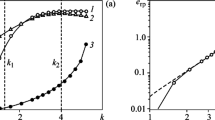Abstract
The bearing capacity of structured materials and the character of their fracture depend on the response of structure elements to the loading conditions. An example of analysis of elastobrittle fracture of materials containing pores or microcracks is used to illustrate the differences in mechanisms of their fracture in the situations of external compression.
We consider the mechanism of influence of structures of these types on the material fracture initiation and the dilatancy due to variations in the stress state and on the character of development of main fractures formed by unifying the cracks growing near active elements of the structure.
Similar content being viewed by others
References
G. S. Pisarenko and A. A. Lebedev, Deformation and Strength of Materials in Complex Stress State (Naukova Dumka, Kiev, 1976) [in Russian].
V. P. Degtyarev, Deformations and Fracture in Highly Stressed Structures (Mashinostroenie, Moscow, 1987) [in Russian].
E. Z. Wang and N. G. Shrivt, “Brittle Fracture in Compression: Mechanics, Models, and Criteria,” Engng Fract. Mech. 52(6), 1107–1126 (1995).
M. Hori and S. Nemat-Nasser, “On Two Micromechanics Theories for Determining Micro-Macro Relations in Heterogeneous Solids,” Mech. Mater. 31, 667–682 (1999).
C. A. Tang, Z. Z. Liang, Y. B. Zhang, et al., “Fracture. Spacing in Layered Materials: A New Explanation Based on Two-Dimensional Failure Process Modeling,” Am. J. Sci. 308, 49–74 (2008).
A. N. Vlasov, “Determination of Strength Characteristics of Structure-Inhomogeneous Media,” Mekh. Komp. Mater. Konstr. 13(2), 209–218 (2007) [J. Comp. Mech. Design (Engl. Transl.)].
W. F. Brace and E. G. Bombolakis, “A Note on Brittle Crack Growth in Compression,” J. Geophys. Res. 68(12), 3709–3713 (1963).
R. V. Goldstein, V. M. Ladygin, and N. M. Osipenko, “A Model of the Fracture of a Slightly Porous Material under Compression or Tension,” Fiz.-Tekh. Probl. Razrab. Polezn. Iskopaemykh, No. 1, 3–13 (1974) [J. Mining Sci. (Engl. Transl.) 10 (1), 1–9 (1974)].
E. Z. Lajtai and V. N. Lajtai, “The Collapse of Cavities,” Int. J. Rock Mech. Min. Sci. Geomech. Abstr. 12, 81–86 (1975).
E. Hoek and Z. T. Bieniawski, “Brittle Rock Fracture Propagation in Rock under Compression,” Int. J. Fract. Mech. 1(3), 137–155 (1965).
T. Plaisted, A. V. Amirkhizi, and S. Nemat-Nasser, “Compression-Induced Axial Crack Propagation in DCDC Polymer Samples: Experiments and Modeling,” Int. J. Fract. 141(3–4), 447–457 (2006).
M. F. Ashby and S. D. Hallam, “The Failure of Brittle Solids Containing Small Cracks under Compression Stress States,” Acta Metall. 34(3), 497–510 (1986).
H. Horii and S. Nemat-Nasser, “Brittle Failure in Compression: Splitting, Faulting, and Brittle-Ductile Transition,” Phil. Trans. Roy. Soc. 319(1549), 337–374 (1986).
L. N. Germanovich, A. V. Dyskin, and N. M. Tsyrulnikov, “AModel of the Deformation and Fracture of Brittle Materials under Uniaxial Compression,” Izv. Akad. Nauk. Mekh. Tverd. Tela, No. 1, 127–143 (1993) [Mech. Solids (Engl. Transl.) 28 (1), 116–128 (1993)].
R. V. Goldstein and N. M. Osipenko, “Fracture and Formation of a Structure,” Dokl. Ross. Akad. Nauk 240(4), 829–832 (1978) [Sov. Phys. Dokl. (Engl. Transl.)].
N. A. Lavrov and L. I. Slepyan, “Brittle Fracture of Elastic Bodies under Compression,” Dokl. Ross. Akad. Nauk 316(5), 1098–1102 (1991) [Sov. Phys. Dokl. (Engl. Transl.) 36, 344–346 (1991)].
Z. Bažant and J. Planas, Fracture and Size Effect in Concrete and Other Quasibrittle Materials (CRC Press, Boca Raton and London, 1998).
B. Haimson and J. W. Rudnicki, “The Effect of the Intermediate Principal Stress on Fault Formation and Fault Angle in Siltstone,” J. Struct. Geol. 32(11), 1701–1711 (2010).
C. G. Sammis and M. F. Ashby, “The Failure of Brittle Porous Solids under Compressive Stress States,” Acta Metall. 34, 511–526 (1986).
R. Böcker, Die Mechanik der bleibenden Formämderung in kristallinish aufgebauten Körpern. Forschungsarbeiten Ing. Wes. (Berlin, 1915).
V. I. Blokh, Theory of Elasticity (Kharkov, 1964) [in Russian].
S. P. Demidov, Theory of Elasticity (Vysshaya Shkola, Moscow, 1979) [in Russian].
I. A. Birger and Ya. G. Panovko (Editors), Strength. Stability. Vibrations, Reference Book, Vol. 1 (Mashinostroenie, Moscow, 1988) [in Russian].
B. C. Heimson, “Borehole Breakouts in Berea Sandstone Reveal a New Fracture,” Pure Appl.Geophys. 160, 813–831 (2003).
R. V. Goldstein and N. M. Osipenko, “Fracture Structures in Intensive Compression,” in Problems of Mechanics of Deformable Solids and Rocks (Fizmatlit, Moscow, 2006), pp. 152–166 [in Russian].
L. N. Germanovich and A. V. Dyskin, “Fracture Mechanisms and Instability of Opening in Compression,” Int. J. Rock Mech. Min. Sci. 37, 263–284 (2000).
Y. Murakami (Editor), Stress Intensity Factors Handbook, Vol. 1 (Pergamon Press, Oxford, 1987; Mir, Moscow, 1990).
G. P. Cherepanov, Mechanics of Rock Failure in Drilling (Nedra, Moscow, 1974) [in Russian].
R. V. Goldstein and N. M. Osipenko, “Structures in Fracture Processes,” Izv. Akad. Nauk. Mekh. Tverd. Tela, No. 5, 49–71 (1999) [Mech. Solids (Engl. Transl.) 34 (5), 39–57 (1999)].
C. Fairhurst and N. G. W. Cook, “The Phenomenon of Rock Splitting Parallel to the Direction of Maximum Compression in the Neighborhood of a Surface,” in Proc. First. Congr. Int. Soc. Rock Mech. (Lisbon, 1966), pp. 687–692.
G. P. Cherepanov, Mechanics of Brittle Failure (Nauka, Moscow, 1974) [in Russian].
Author information
Authors and Affiliations
Corresponding author
Additional information
Original Russian Text © R.V. Goldstein, N.M. Osipenko, 2015, published in Izvestiya Akademii Nauk. Mekhanika Tverdogo Tela, 2015, No. 2, pp. 44–59.
About this article
Cite this article
Goldstein, R.V., Osipenko, N.M. Influence of the form of material structure elements on the fracture scenario in a complex stress state. Mech. Solids 50, 147–159 (2015). https://doi.org/10.3103/S0025654415020041
Received:
Published:
Issue Date:
DOI: https://doi.org/10.3103/S0025654415020041




